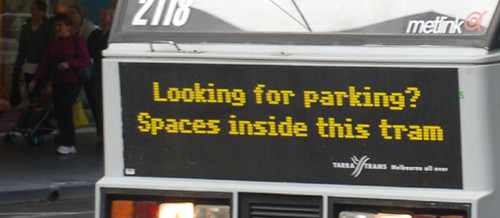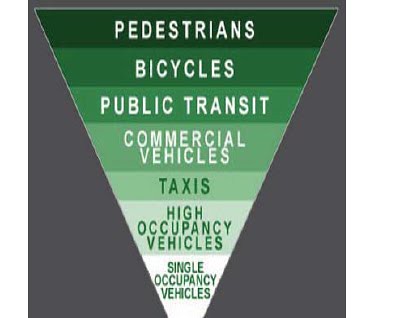Sustainable transportation policy, City of Stonnington, Victoria State, Australia

Tram in Melbourne with a pro-transit message. Photo by Ethan Kent, PPS.
For what it's worth, transportation demand management planning protocols for the most part were first developed in Victoria State, Australia. The TravelSmart program there is the first that I know of that initiated and implemented a wide variety of protocols for inducing mode shift to more sustainable transportation modes. The kinds of programs that Arlington County Virginia does are based on that program, although ArCo doesn't go into the depth of the Australian program.
I was looking up something on the web, and I came across the above-cited transportation policy for the City of Stonnington, which has about 90,000 residents, is located just outside of the Central Business District of Melbourne, and is about 10 square miles. (Arlington County has a very similar set of policies.)
From the Stonnington Sustainable Transport Policy:
Policy principles
Deliver Priority
In recognising that travel relates to the movement of people (and goods where appropriate) and not to the movement of vehicles, priority will be given to transport modes in the following order:
• Walking
• Cycling
• Public Transport
• Commercial vehicles serving local businesses and institutions
• Multiple-occupancy vehicles
• Single-occupancy vehicles
Preference will be given to more sustainable modes of transport in terms of allocating Council time, space and resources.
Moderate the Impact of Cars
Council will strive to reduce car dependence and to minimise associated impacts by working towards having more people in the municipality choose to walk, cycle and use public transport more often and drive cars less, particularly for short and local trips, through increasing local shopping, employment, education, recreation and other travel destinations accessed daily by people of all abilities and economic means.
Increase Connections
Council will strive to improve pedestrian, cyclist and public transport connections, accessibility and permeability within and between activity centres and other parts of the municipality by providing direct and legible travel pathways and functional multi-modal interchanges to enable people to reach their destinations with ease, efficiency and in comfort.
Improve Safety
Council will strive to provide conditions, which encourage activity, reduce the potential for injury, and improve actual and perceived safety in order to increase public transport use, cycling and walking in public spaces.
Raise Profile
Council will raise the profile of walking, cycling and public transport and the health and environmental benefits of these modes, through the provision of information, facilities and active promotion, both internally and externally, to compel people to change their travel behaviour when accessing their everyday needs.
This comes up all the time in terms of discussions on this blog and on others. I focus on optimal mobility, or what Transportation Alternatives calls the Sustainable Transportation Hierarchy.

Most communities, including DC, don't prioritize transportation in this manner.
Not having an equivalent policy in DC always worries me when City Council legislates various aspects of transportation policy in bits and pieces, from proposing free parking for funerals, angle parking to accommodate churches on Sundays, tax incentives for gas stations, streetcars, tolls on the 14th Street bridge, etc., there's no overall plan, no overall vision, but worse, there's no recognition of the need for an overall plan and vision.
Labels: transportation planning



0 Comments:
Post a Comment
<< Home